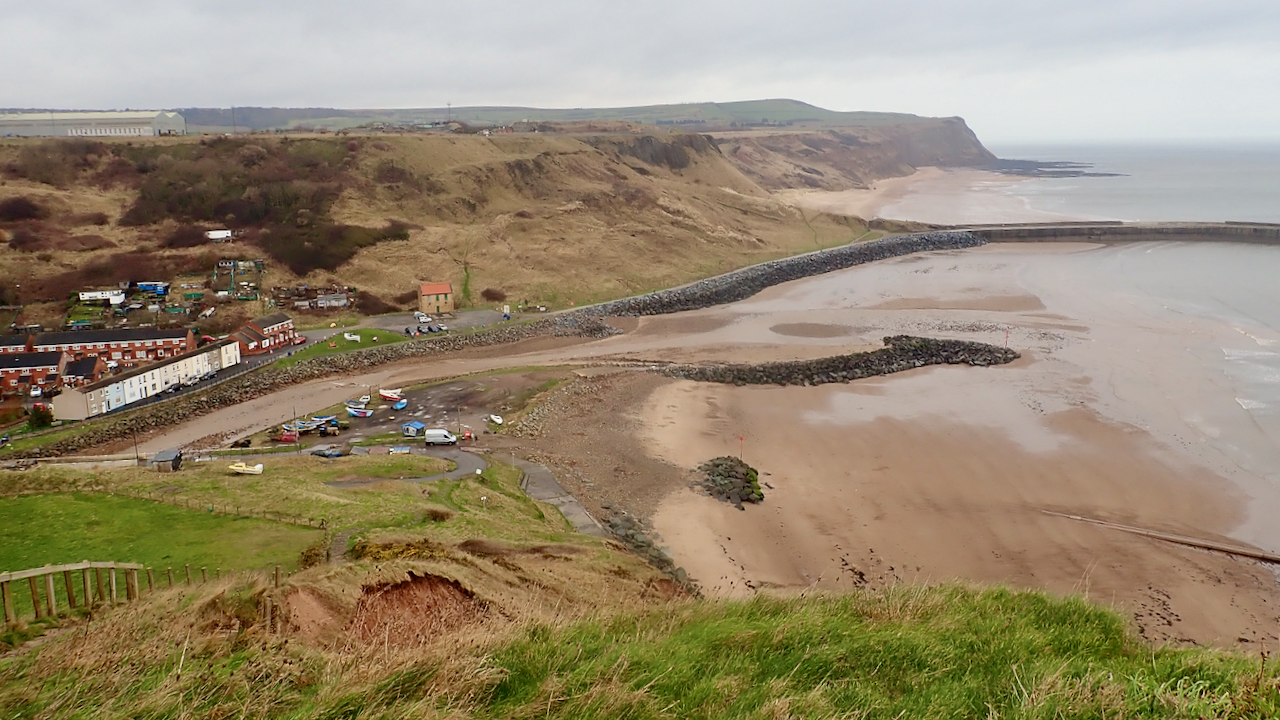When ‘J.G.’ passed through Skinningrove bay in 1866 on his way from Saltburn to Whitby, the village must have looked very different. The stone built houses were set back from the shore, to give some shelter from the North Sea; the rows of terraced cottages had still to be built. To visualise it best, it’s a good idea to have the 1856 Ordnance Survey map open in a separate window/tab.The towering cliffs on the far side are later, built up through decades of dumping waste slag from the ironworks, the modern reincarnation of which can be seen on the top left of the photo. Although you can’t really see it from the photo, beyond the black cliffs, a whole ghyll, Cattersty Beck, has been infilled. The jetty dates from the time of the ironworks and the eastern breakwater I think was substantially enlarged in 1999/2000 when the sea defences were constructed with armourstone blocks imported in from Norway1Goldring, Denis. “Along the Scar”. published by Peter Tuffs 2001.
I say, think, because the improvement of Skinningrove Beck was the first job I worked on when I came up to the area in 1973, but I just can not remember how much of a breakwater was there then. The job involved the construction of works to clean the beck which had become discoloured through orange ochreous sediments seeping out from the abandoned ironstone mines. Thirty years later and the beck had turned orange again and more treatment works had to be constructed.
But back to ‘J.G.’ who wrote anonymously of his two day walk in the Yorkshire Gazette. Here is an extract, setting off from Saltburn he writes:
Enchanting as everything appeared we had no time to linger, so we began our trip from the beach and walked onward to Huntcliff, on the way to Whitby. This cliff rises to an elevation of 360 feet, upon which the men at the ironworks of Mr. Morrison are engaged in removing the earth which overlie the ironstone, and filling trucks with the ironstone and taking it away on iron rails by an engine to a depot, from whence it is taken by rails to Middlesbro’ to the blasting furnaces. Whilst some part of the mining had been done by gunpowder explosion, we saw some of the men working at the extreme edge of the cliff removing the earth and rubbish from the surface of the ironstone and throwing it over the cliff; and others with mattocks removing the ironstone and filling the trucks, – a more simple and inexpensive method cannot be conceived. The seam crops out near the surface, and the wealth in iron ore to be extracted from these hills must be in calculable We took a few specimens of the mineral and walked onward through a gorge where gorse and ferns and shrubs in their native beauty luxuriate, and entered Skinningrove Bay. Here all was solitude. The beach appeared to be rarely trod, except by the foot of the occasional tourist, or the miner at the Lofthouse works. The glen and stream of Lofthouse, with their native beauties, had to be passed by, when we scrambled up the rock cliff and on to Boulby; this elevation is 660 feet above the sea. Care must be taken all along these cliffs that the edge is not approached too nearly, for otherwise the danger is imminent; here and there the pathway of even recent time has fallen away into the sea, and the margin left between the stone boundary of the adjoining fields and the edge of the cliff is so narrow that the pathway is dangerous to walk upon. Wherever this happens it is always better to get over the stone fence and walk in the adjoining fields until the pathway becomes less near the edge of the cliff, or is otherwise safe. In several places the stone fence of some of the fields will be soon undermined and fall into the sea2“A Visit to the Sea Cliffs of Cleveland.” Yorkshire Gazette, 14 July 1866, p. 2. British Library Newspapers, link-gale-com.ezproxy.is.ed.ac.uk/apps/doc/JF3231097707/GDCS?u=ed_itw&sid=GDCS&xid=a5468420. Accessed 10 Mar. 2021..
As I said ,this was written in 1866 and, bearing in mind the Huntcliff Ironstone Mine did not commence operations until 18723Tuffs, Peter. “Catalogue of Cleveland Ironstone Mines”. Cleveland Ironstone Series 1996., the same year the Saltburn to Brotton extension of the Cleveland Railway was completed4Wikipedia Contributors. “Cleveland Railway (England).” Wikipedia, Wikimedia Foundation, 1 Jan. 2021, en.wikipedia.org/wiki/Cleveland_Railway_(England)#Mergers,_onward_connections_and_closures. Accessed 10 Mar. 2021., I am curious that ‘J.G.’ mentions ironstone mining. Was this a small scale trial? But he writes of trucks and rails to Middlesbrough?
Addendum
Chris has quickly come back to me. Thanks Chris.
It seems I was wrong to assume the ironstone activities were at Huntcliff Mine. They would have been at Cliff where ironstone was quarried prior to the building of the railway. In 1865, Bell Brothers brought the lease and once the railway came along, sank two shafts either side of the railway. The underground workings were eventually connected to the Bell Bros. Huntcliff Mine 5Tuffs, Peter. “Catalogue of Cleveland Ironstone Mines”. Cleveland Ironstone Series 1996.
I have added a pin (gold) to the map. So the site of these workings are just hidden by the bulk of Warsett Hill.
- 1Goldring, Denis. “Along the Scar”. published by Peter Tuffs 2001
- 2“A Visit to the Sea Cliffs of Cleveland.” Yorkshire Gazette, 14 July 1866, p. 2. British Library Newspapers, link-gale-com.ezproxy.is.ed.ac.uk/apps/doc/JF3231097707/GDCS?u=ed_itw&sid=GDCS&xid=a5468420. Accessed 10 Mar. 2021.
- 3Tuffs, Peter. “Catalogue of Cleveland Ironstone Mines”. Cleveland Ironstone Series 1996.
- 4Wikipedia Contributors. “Cleveland Railway (England).” Wikipedia, Wikimedia Foundation, 1 Jan. 2021, en.wikipedia.org/wiki/Cleveland_Railway_(England)#Mergers,_onward_connections_and_closures. Accessed 10 Mar. 2021.
- 5Tuffs, Peter. “Catalogue of Cleveland Ironstone Mines”. Cleveland Ironstone Series 1996.

Leave a Reply